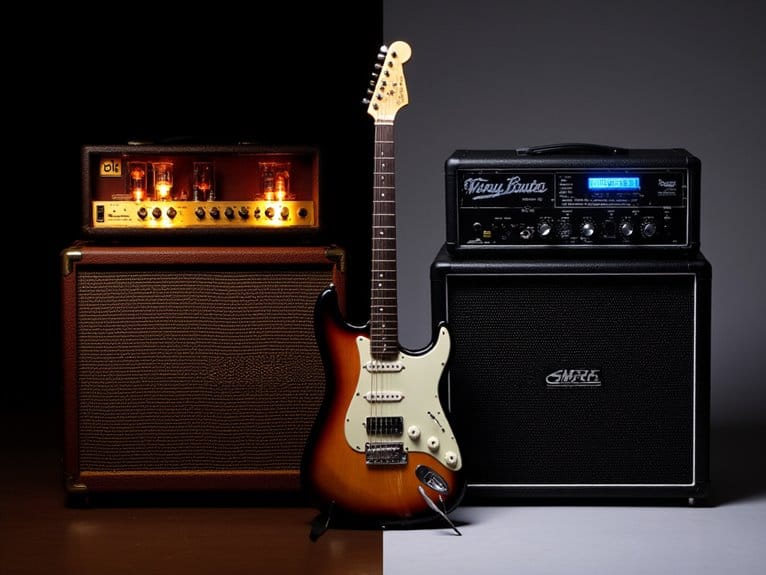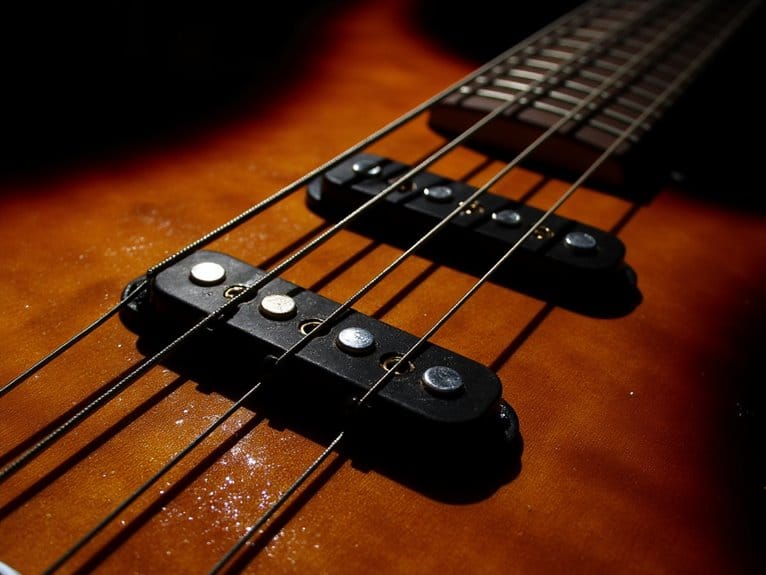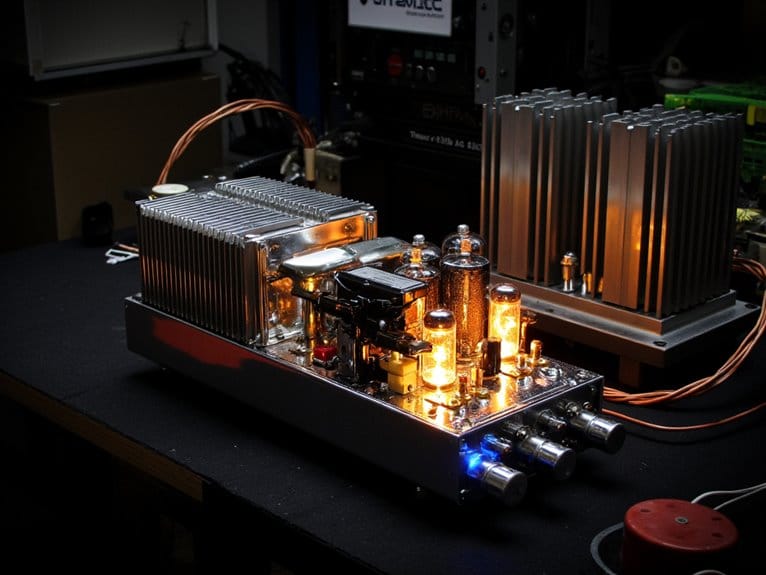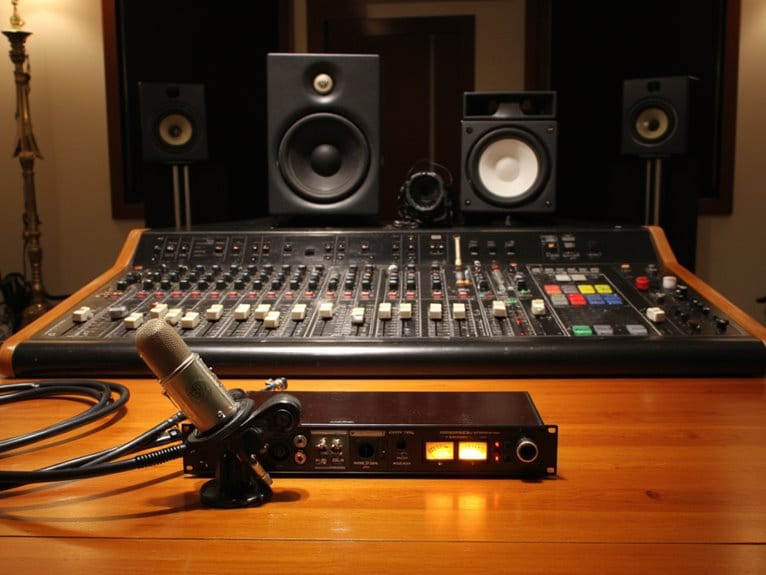Guitar Amp Vs Modeling: Pros and Cons for Different Situations
You’ll find modeling amps excel in smaller venues with their 11-14 kg weight, hundreds of built-in effects, and $200-300 price point, while tube amps deliver superior organic dynamics and tonal richness that cuts through larger spaces despite weighing 18+ kg and costing $700+. Modeling offers preset versatility and lower maintenance, but tube amps provide the immediate response and warm overdrive that connects emotionally with audiences, maintaining better resale value long-term. The choice depends on your specific performance needs and venue requirements.
We are supported by our audience. When you purchase through links on our site, we may earn an affiliate commission, at no extra cost for you. Learn more.
Notable Insights
- Modeling amps weigh 11-14 kg versus tube amps at 18+ kg, making them significantly easier to transport and set up for frequent gigging.
- Tube amps deliver superior dynamic response and organic tone warmth, while modeling amps offer consistent performance with hundreds of built-in effects.
- Initial costs favor modeling amps ($200-300) over tube amps ($700+), though tube amps maintain better resale value and long-term reliability.
- Small venues benefit from modeling amps’ compact size and quick setup, while larger spaces showcase tube amps’ natural sound projection and presence.
- Modeling amps excel in versatility with preset recall and built-in features, whereas tube amps provide authentic overdriven tones and emotional audience connection.
Weight, Portability, and Physical Considerations
When you’re lugging gear to your third gig this week, the weight differences between a traditional tube amp and a modeling amp becomes painfully obvious.
Your back will thank you after hauling a 14-kilogram modeling amp instead of an 18-kilogram tube beast to multiple venues.
Modeling amps typically weigh around 11.5 to 14 kilograms, while traditional valve amps can reach 18.2 kilograms or more, thanks to heavy transformers and tubes that add substantial bulk.
I’ve noticed that transport ease becomes essential when you’re dealing with frequent setups and teardowns.
Modeling amps offer integrated amplifier-speaker combinations in compact units, eliminating the need for multiple pieces of gear.
However, the weight advantage diminishes when considering smaller heads with Neo cabinets, making the portability difference less significant than many assume.
Traditional tube amps, despite their tonal advantages, require more vehicle space and physical effort. Additionally, fragile tubes need protective covers during transport, adding another consideration for gigging musicians.
Many musicians pair their amps with affordable audio interfaces for recording purposes, which can add convenience for those who need both live performance and studio capabilities.
For musicians with travel demands or physical limitations, the portability benefits of modeling technology make a compelling case.
Professional recording setups commonly use 24-bit/192kHz conversion for capturing the highest audio detail and dynamic range.
Compact recording setups can be enhanced with USB-C interfaces that provide professional-grade audio conversion without requiring additional AC power sources.
Sound Quality and Tonal Performance Comparison
How does the sound quality between traditional tube amps and modeling technology actually stack up in real-world applications?
The dynamic response you’ll experience with tube amps provides immediate, tactile feedback that affects your timing and emotional connection to the music, while modeling amps introduce slight latency that can disrupt these subtle nuances.
You’ll notice the tonal richness of real tube amps generates complex harmonics and overtones, producing warmer, more musically satisfying sounds. Different tube configurations like 12AX7/EL84 combinations create bright characteristics while 6V6GT tubes deliver enhanced warmth in the overall sound signature.
However, I’ve found that modeling technology has improved remarkably, making clean tones quite accurate and the differences less noticeable through PA systems. Modern modeling amps now include features like Bluetooth connectivity for streaming backing tracks while maintaining their sound quality focus.
While overdriven tones still favor tube amps for their natural saturation and feedback authenticity, modeling amps offer consistent performance. The wattage output of your amplifier directly impacts how much loudness you can achieve before distortion occurs, affecting both tube and modeling amps differently.
Real amps excel at delivering crucial elements like proper note decay, natural feedback bloom, and responsive volume pot interaction that digital modeling still struggles to replicate convincingly.
Versatility, Features, and Flexibility Options
While sound quality remains an essential consideration, the versatility and feature differences between traditional tube amps and modeling technology create equally important distinctions that’ll greatly impact your playing experience and practical needs.
I’ve found that modeling versatility truly shines when you need multiple tones instantly, offering hundreds of amp models across genres without hauling multiple cabinets to gigs. The effect features in modeling amps eliminate your need for extensive pedal boards, providing built-in reverb, delay, and modulation with preset recall capabilities that guarantee consistent tone settings.
Traditional tube amps, however, require external effects and manual adjustments, which some players prefer for hands-on control, though they lack the immediate adaptability that cover bands and studio musicians often demand for diverse musical situations. Professional recording setups benefit from low latency monitoring systems that allow real-time feedback without distracting delays during performance tracking. Modern connectivity features like Bluetooth 5.0 integration in today’s amplifiers also provide wireless streaming capabilities that enhance practice sessions and performance flexibility. Additionally, quality frequency response considerations apply to amplification equipment just as they do with microphones, where the ideal range preservation affects how your guitar’s tonal characteristics are reproduced through the system.
Cost Analysis and Long-Term Reliability Factors
Three critical financial factors separate modeling amps from traditional tube amplifiers when you’re calculating the true cost of ownership over several years of regular use.
Your initial investment typically favors modeling technology, with budget options starting around $200-$300 compared to tube amps beginning at $700 or higher for decent quality.
However, I’ve observed that tube amps maintain superior resale value, often appreciating over time, while modeling amps depreciate rapidly due to technological obsolescence.
You’ll spend less on maintenance with modeling amps since they don’t require tube replacements, consume less power, and weigh considerably less for transport. The lightweight design of modeling amps makes them significantly easier to transport for frequent gigs, with some weighing as little as a few pounds compared to heavier tube alternatives. Many quality modeling amps under $200 feature amp modeling that emulates classic brands like Fender, Marshall, and Vox, making them excellent choices for budget-conscious musicians.
The reliability advantage goes to solid-state components, though vintage tube amps can become valuable investments if properly maintained.
Similar to studio headphones that should be replaced every 3-5 years, modeling amps may require more frequent upgrades as software and digital technology advances outpace older hardware capabilities.
Venue Requirements and Application Scenarios
When you’re choosing between modeling and traditional tube amps, the venue you’ll play determines which technology serves your needs better, and I’ve learned this lesson through countless gigs ranging from cramped coffee shops to outdoor festivals.
In small bars and cafes, where venue size restricts your stage space and quick setup matters, modeling amps excel with their 11-19 kg weight advantage over 32 kg tube amps.
Plus, they eliminate bulky speaker cabinets that create trip hazards.
However, their acoustic adaptability suffers in larger venues where tube amps provide natural stage presence and warm overdrive characteristics that cut through mix better.
I’ve noticed modeling amps sound digital at high volumes, while tube amps deliver organic dynamics that connect emotionally with audiences in medium to large spaces.
Frequently Asked Questions
Can I Use Modeling Amps for Recording Without Additional Software or Interfaces?
You can record with modeling amps alone using their USB outputs, but you’ll face recording quality limitations compared to dedicated interfaces and software limitations regarding advanced routing and processing options.
Do Modeling Amps Work Well With External Pedals and Effects Chains?
You’ll find excellent pedal compatibility with modeling amps, though placement matters for ideal tone shaping. Place overdrives before the amp input, while time-based effects work best through the effects loop when available.
How Do Modeling Amps Perform at Bedroom Practice Volumes Versus Performance Levels?
You’ll find modeling amps excel at bedroom practice volumes, maintaining excellent tone clarity without noise. At performance levels, they’re capable but may lack the dynamic feel that tube amps deliver.
Can Tube Amps Be Converted to Silent Recording Setups Using Load Boxes?
You can absolutely convert tube amps for silent recording techniques using load boxes, eliminating speaker noise while preserving authentic tone. These tube amp modifications don’t require permanent changes—just connect the load box to your amp’s speaker output.
On a final note
You’ll find that neither guitar amps nor modeling solutions represent a universally superior choice, as each excels in specific scenarios based on your individual requirements, performance contexts, and budget constraints. If you’re primarily playing smaller venues or home studios, modeling units offer exceptional versatility and convenience, while traditional amplifiers remain unmatched for large stage performances where authentic tube saturation and physical speaker response create that irreplaceable sonic presence you’re seeking.







